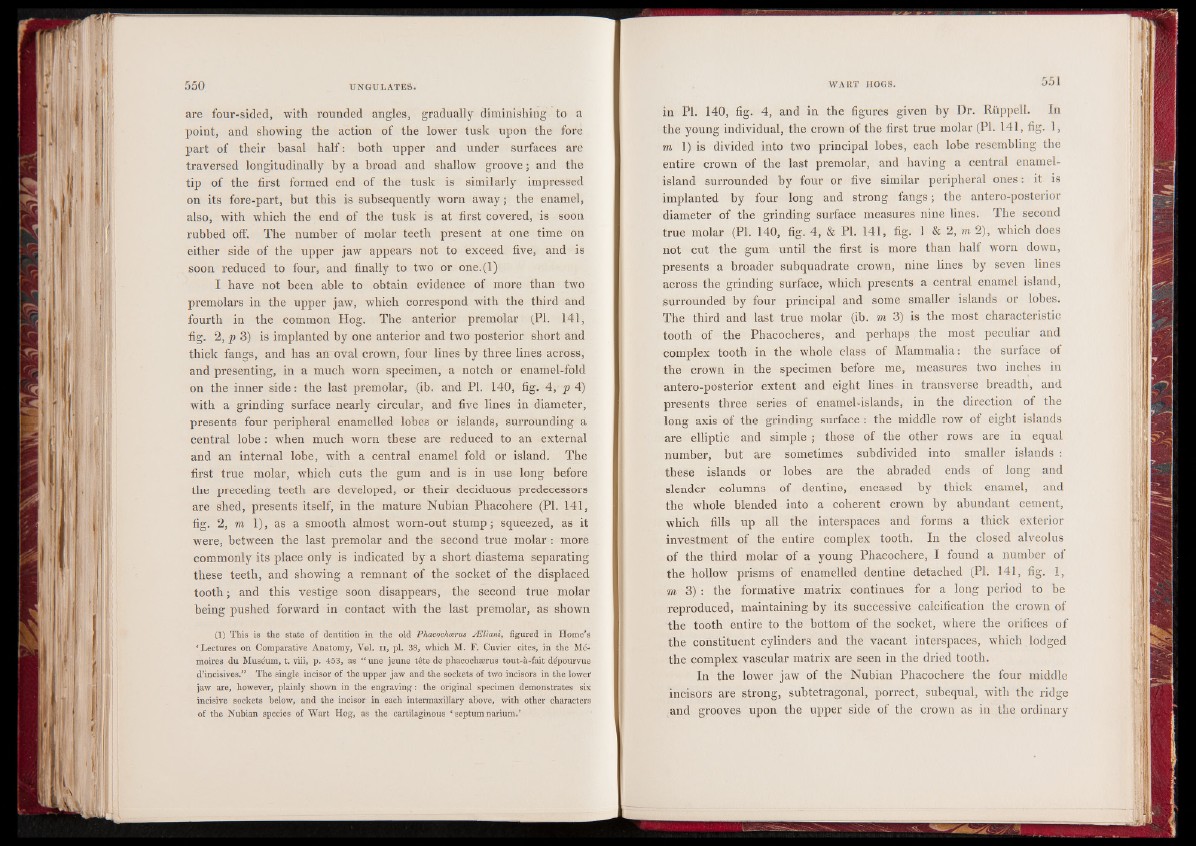
are four-sided, with rounded angles, gradually diminishing to a
point, and showing the action of the lower tusk upon the fore
part of their basal half : both upper and under surfaces are
traversed longitudinally by a broad and shallow groove ; and the
tip of the first formed end of the tusk is similarly impressed
on its fore-part, but this is subsequently worn away ; the enamel,
also, with which the end of the tusk is at first covered, is soon
rubbed oflf. The number of molar teeth present at one time on
either side of the upper jaw appears not to exceed five, and is
soon reduced to four, and finally to two or one.(l)
I have not been able to obtain evidence of more than two
premolars in the upper jaw, which correspond with the third and
fourth in the common Hog. The anterior premolar (PI. 141,
fig. 2, p 3) is implanted by one anterior and two posterior short and
thick fangs, and has an oval crown, four lines by three lines across,
and presenting, in a much worn specimen, a notch or enamel-fold
on the inner side: the last premolar, (ib. and PI. 140, fig. 4, p 4)
with a grinding surface nearly circular, and five lines in diameter,
presents four peripheral enamelled lobes or islands, surrounding a
central lobe : when much worn these are reduced to an external
and an internal lobe, with a central enamel fold or island. The
first true molar, which cuts the gum and is in use long before
the preceding teeth are developed, or their deciduous predecessors
are shed, presents itself, in the mature Nubian Phacohere (PI. 141,
fig. 2, m 1), as a smooth almost worn-out stump; squeezed, as it
were, between the last premolar and the second true molar : more
commonly its place only is indicated by a short diastema separating
these teeth, and showing a remnant of the socket of the displaced
tooth ; and this vestige soon disappears, the second true molar
being pushed forward in contact with the last premolar, as shown
(1) This is the state of dentition in the old Phacochærus Æliani, figured in Home’s
‘Lectures on Comparative Anatomy, V©1. iff pi. 38, which M. F. Cuvier cites, in the Mémoires
du Museum, t. viii, p. 453, as “ une jeune tête de phacochærus tout-à-fait dépourvue
d’incisives.” The single incisor of the upper jaw and the sockets of two incisors in the lower
jaw are, however, plainly shown in the engraving : the original specimen demonstrates six
incisive sockets below, and the incisor in each intermaxillary above, with other characters
of the Nubian species of Wart Hog, as the cartilaginous * septum narium.’
in Pi. 140, fig. 4, and in the figures given by Dr. Rüppell. In
the young individual, the crown of the first true molar (PI. 141, fig. 1,
m 1) is divided into two principal lobes, each lobe resembling the
entire crown of the last premolar, and having a central enamel-
island surrounded by four or five similar peripheral ones : it is
implanted by four long and strong fangs ; the antero-posterior
diameter of the grinding surface measures nine lines. The second
true molar (PL 140, fig. 4, & PL 141, fig. 1 & 2, m 2), which does
not cut the gum until the first is more than half worn down,
presents a broader subquadrate crown, nine lines by seven lines
across the grinding surface, which presents a central enamel island,
surrounded by four principal and some smaller islands or lobes.
The third and last true molar (ib. m 3) is the most characteristic
tooth of the Phacochères, and perhaps the most peculiar and
complex tooth in the whole class of Mammalia: the surface of
the crown in the specimen before me, measures two inches in
antero-posterior extent and eight lines in transverse breadth, and
presents three series of enamel-islands, in the direction of the
long avis of the grinding surface : the middle row of eight islands
are elliptic and simple ; those of the other rows are in equal
number, but are sometimes subdivided into smaller islands :
these islands or lobes are the abraded ends of long and
slender columns of dentine, encased by thick enamel, and
the whole blended into a coherent crown by abundant cement,
which fills up all the interspaces and forms a thick exterior
investment of the entire complex tooth. In the closed alveolus
of the third molar of a young Phacochère, I found a number ot
the hollow prisms of enamelled dentine detached (PL 141, fig. 1,
m 3) : the formative matrix continues for a long period to be
reproduced, maintaining by its successive calcification the crown of
the tooth entire to the bottom of the socket, where the orifices of
the constituent cylinders and the vacant interspaces, which lodged
the complex vascular matrix are seen in the dried tooth.
In the lower jaw of the Nubian Phacochère the four middle
incisors are strong, subtetragonal, porrect, subequal, with the ridge
and grooves upon the upper side of the crown as in the ordinary